- have liver problems
- plan to have surgery
- have chicken pox or measles or have recently been near anyone with chicken pox or measles
- have an infection
- have high blood sugar levels (prediabetes or diabetes)
- have glaucoma or cataracts
- have a family history of diabetes or glaucoma
- have or have had tuberculosis
- have high blood pressure (hypertension)
- have decreased bone mineral density (osteoporosis)
DISCOVER TARPEYO
First and only FDA-approved treatment proven to reduce the loss of kidney function in adult patients with IgA Nephropathy (IgAN)
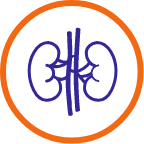
First and only FDA-approved treatment for IgAN proven to reduce the loss of kidney function
Significantly reduces the loss of kidney function compared to blood pressure medication alone, as measured by eGFR*
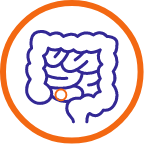
Only FDA-approved treatment designed to target a source of IgAN in the gut
Designed to deliver treatment to an area of the gut thought to play a role in IgAN†

Lasting results
9-month treatment with proven results over 2 years in 2 key measures (eGFR and UPCR)‡
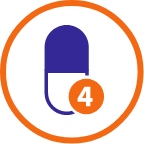
9-month treatment
4 capsules taken once a day

TARPEYO Touchpoints® offers programs to help you access and afford your medication
97% of TARPEYO patients have paid less than $10 per prescription§
*At 2 years, there was -5.3 mL/min/1.73 m 2 vs -11.2 mL/min/1.73 m 2 difference in kidney function as measured by eGFR in patients who received TARPEYO + blood pressure medication vs those who received blood pressure medication alone.
†It has not been established to what extent the efficacy of TARPEYO is from local effects (in the gut) vs systemic effects (in circulation).
‡At 2 years, there was an average 34% reduction from baseline in UPCR in patients who received TARPEYO plus blood pressure medication vs. 4% in those who received blood pressure medication alone.
§All patients regardless of insurance type. This includes commercial, Medicare, Medicaid, and cash-paying patients from January 2022 through February 2024.
HOW IS TARPEYO THOUGHT TO WORK?
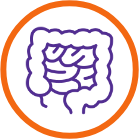

TARPEYO is designed to deliver treatment to an area of the gut thought to play a role in IgAN. Types of cells in the gut are responsible for the production of an antibody called IgA1, which can build up in the kidneys, causing IgAN. TARPEYO can reduce the amount of this antibody.*
*It has not been established to what extent the efficacy of TARPEYO is from local effects (in the gut) vs systemic effects (in circulation).
WHAT MAKES TARPEYO UNIQUE?
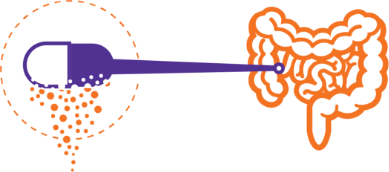

The TARPEYO capsule was designed with targeted-release technology to dissolve once
it reaches a specific area of the gut to target the IgA1 antibodies that eventually build
up in your kidneys.
HOW WAS TARPEYO STUDIED?


TARPEYO was studied in 364 patients over 2 years. For 9 months, patients were on TARPEYO plus their prescribed blood pressure medicine. Then they were followed for 15 months off treatment for an observational period. The primary objective of the 2-year study was to assess the impact of TARPEYO on eGFR, a measure of kidney function. Changes in proteinuria, as measured by change in UPCR, was another objective and measured in the study. Patients in the placebo (sugar pill) control group of the study took blood pressure medicine alone.
WHAT ARE THE STUDY RESULTS WITH TARPEYO?
TARPEYO was shown to reduce the loss of kidney function vs blood pressure medication alone

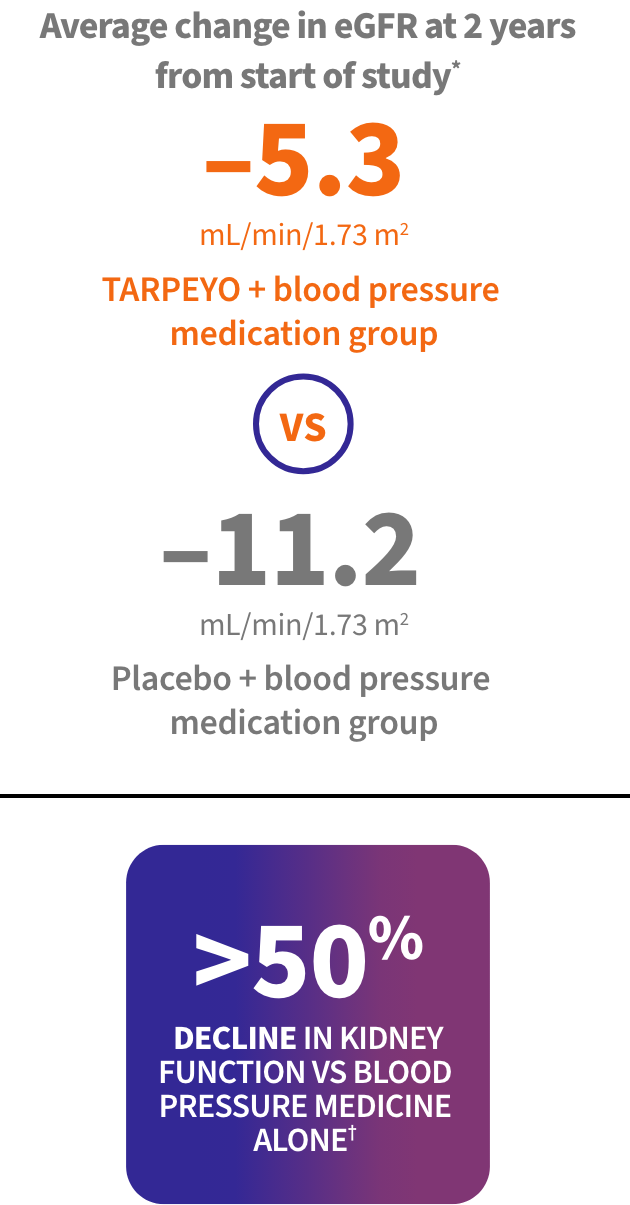
As kidney function worsens, the eGFR number goes down. At the end of the study, people who took TARPEYO and blood pressure medication lost less of their kidney function compared to those who only took blood pressure medicine.
*At the start of the study, the average eGFR was approximately 58 mL/min/1.73 m2, with 60% of patients having an eGFR <60 mL/min/1.73 m2.
†At 2 years, there was >50% difference in kidney function as measured by eGFR in patients who received TARPEYO + blood pressure medication vs those who received blood pressure medication alone. Calculated as relative reduction (9.4% TARPEYO + blood pressure medicine vs 20.3% blood pressure medicine alone).
TARPEYO was shown to reduce urine protein levels vs blood pressure medication alone

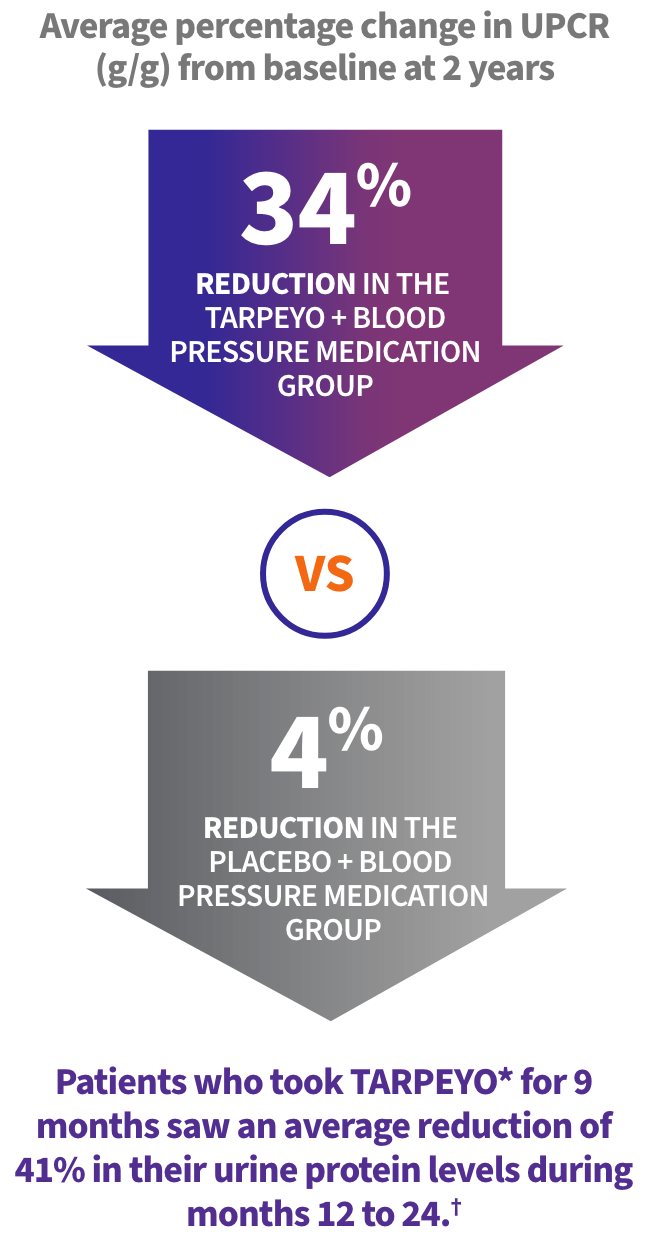
*Taken with blood pressure medicine.
†Average UPCR percentage reduction during follow-up (over 12 to 24 months) based on longitudinal repeated measures model.
WHAT ARE THE POSSIBLE SIDE EFFECTS OF TARPEYO?
The most common side effects of TARPEYO include:
- swelling of the lower legs, ankles, and feet
- high blood pressure
- muscle spasms
- acne
- headache
- upper respiratory tract infection
- swelling of the face
- weight increase
- indigestion
- irritation or inflammation of the skin
- joint pain
- increased white blood cell count
These are not all the possible side effects of TARPEYO. Call your doctor for medical advice about side effects. You may report side effects to FDA at 1-800-FDA-1088.
TARPEYO may cause serious side effects, including effects of having too much corticosteroid medicine in your blood (hypercorticism), adrenal suppression, and risk of immunosuppression.
87% of patients in the clinical study completed the 2-year study

Blood pressure: Increases in blood pressure were small and resolved to baseline levels by the end of the 9-month treatment period

Weight gain: Increases in body weight were minor and did not exceed 2.2 lb. Patients returned to pretreatment weight within 3 months of ending treatment
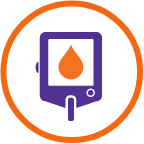
HbA1c: HbA1c was generally unchanged throughout treatment. Increases in HbA1c observed during treatment generally resolved after the end of treatment


